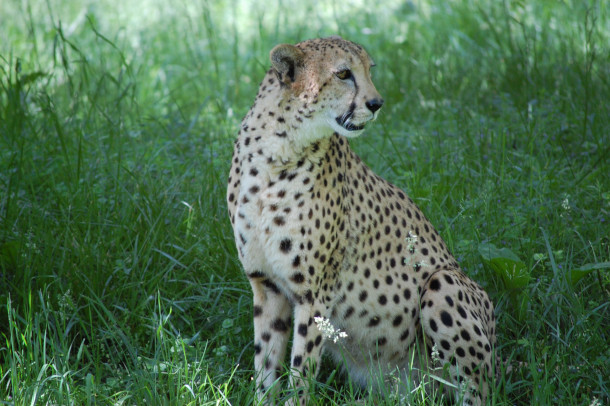Beyond the Headlines
Air Date: Week of September 23, 2022

A test from Environmental Health News and wellness website Mamavation found that 13 out 39 brands of dental floss tested positive for a chemical linked to PFAS. (Photo: Marco Verch, Flickr, CC BY 2.0)
This week, Environmental Health News Editor Peter Dykstra and Host Bobby Bascomb discuss the discovery of harmful PFAS “forever chemicals” in some brands of dental floss. Also, decades after becoming locally extinct, cheetahs have been brought back to India. And in history, a look centuries back to when famous Portuguese explorer Ferdinand Magellan embarked on a circumnavigation of the world, though he didn’t actually make it all the way.
Transcript
CURWOOD: It’s Living on Earth, I’m Steve Curwood.
BASCOMB: And I’m Bobby Bascomb.
Well, it's time for a trip now beyond the headlines with Peter Dykstra. Peter's an editor with Environmental Health News, that's ehn.org and dailyclimate.org. Hey there, Peter, what do you have for us today?
DYKSTRA: Well, hi, Bobby. We've talked a lot on the show about PFAS, the forever chemicals, as they're known and where they've been found in so many consumer goods. We got a new one for you: dental floss, particularly the waxy floss that goes through your teeth so easily. My organization EHN and the Mamavation website, it's a leading website for wellness, combined to test 39 different brands of dental floss, and 13 of those 39 tested positive for the PFAS chemical family linked to reproductive problems, birth defects, testicular cancer, and other maladies.
BASCOMB: Oh, gosh, well, I'll definitely have to check out that list, Peter. I mean, as you mentioned, PFAS are in just so many products that we are all exposed to all the time. Last thing we want to do is purposefully put it in our mouth every night when we're trying to do something good for our health. So do we have a list or something we can share with our listeners that will point them towards a dental floss that might be safe and, you know, not so painful?
DYKSTRA: All of the results of the EHN and Mamavation tests can be found on our website at loe.org.
BASCOMB: Well, we'll definitely have to check that out. What else do you have for us this week?
DYKSTRA: Well, we're looking at some potential, potential good news. We can never talk enough about the good news on the environmental beat when it comes along. But after 75 years of localized extinction, an experiment has brought cheetahs back to India. Seventy five years ago, they were wiped out. Now a modest population of eight cheetahs have been reintroduced to a national park.

After decades of local extinction in India, eight cheetahs were recently welcomed into the country and released into a national park. (Photo: Sadie Hart, Flickr, CC BY 2.0)
BASCOMB: Wow, that is encouraging. I'm sure they are an important part of the ecosystem that's been missing all this time.
DYKSTRA: That's right, there used to be thousands of cheetahs in India. They were wiped out about halfway into the 20th century by hunting in other parts of Asia, in the Arabian Peninsula, and then much of Africa. But there are about 8,000 cheetahs, these magnificent animals, they remain in Namibia and neighboring countries.
BASCOMB: And how do they plan to protect them in India? I mean, they went extinct there once, how is this time going to be any different for them?
DYKSTRA: Well, these animals are in a national park, and hopefully the extra protection there will help them to thrive. One concern is anytime you have a population of eight animals, that may not necessarily be enough to breed survivors.
BASCOMB: I believe cheetahs are more or less solitary animals, so it's not like they're living in groups where they can easily find each other.
DYKSTRA: No, I mean, there have been similar problems with animals like even the blue whale, the largest animal in the world, ocean or land. The blue whales were hunted so intensively that they have a hard time finding each other. If you have that small a central population, you're going to have a really hard time breeding healthy animals.
BASCOMB: Well, let's wish them luck and take a look in the history books. What do you see for us this week?
DYKSTRA: We're gonna go way back in history to September 20, 1519. That is the date that a fleet of five ships under Captain Ferdinand Magellan left Portugal on what turned out to be the first successful circumnavigation of the world, at least by Europeans. The fleet was mostly sponsored by the king of Spain, and only one of Magellan five ships actually made it all around the world. And you know who didn't make it? Magellan.

The monument of Ferdinand Magellan in Punta Arenas memorializes the famed Portuguese sailor and his exploration around the world. (Photo: Thomas Liptak, Flickr, CC BY-NC-ND 2.0)
BASCOMB: Oh, what happened to him?
DYKSTRA: Racism and conquest being a big part of what they did and what they were after, it's probably the reason that Magellan was killed by a poison arrow in the Philippines in the year 1521 when he was only 41 years old. He made it halfway around the world.
BASCOMB: Wow. So he didn't complete the trip, but he still gets the credit in the history books.
DYKSTRA: He does. And I couldn't tell you the name of the captain who actually made it back to Portugal.
BASCOMB: Exactly. All right. Well, thanks, Peter. Peter Dykstra is an editor with Environmental Health News, that's ehn.org and dailyclimate.org. We'll talk to you again real soon.
DYKSTRA: All right, Bobby, thanks a lot. Talk to you soon.
BASCOMB: And there's more on the stories on the Living on Earth website. That's loe dot org.
Links
Environment Health News | “Tests Find PFAS Abundant in Some Dental Floss”
The New York Times | “After 75 Years, Cheetahs Return to India in a Grand Experiment”
Living on Earth wants to hear from you!
Living on Earth
62 Calef Highway, Suite 212
Lee, NH 03861
Telephone: 617-287-4121
E-mail: comments@loe.org
Newsletter [Click here]
Donate to Living on Earth!
Living on Earth is an independent media program and relies entirely on contributions from listeners and institutions supporting public service. Please donate now to preserve an independent environmental voice.
NewsletterLiving on Earth offers a weekly delivery of the show's rundown to your mailbox. Sign up for our newsletter today!
 Sailors For The Sea: Be the change you want to sea.
Sailors For The Sea: Be the change you want to sea.
 The Grantham Foundation for the Protection of the Environment: Committed to protecting and improving the health of the global environment.
The Grantham Foundation for the Protection of the Environment: Committed to protecting and improving the health of the global environment.
 Contribute to Living on Earth and receive, as our gift to you, an archival print of one of Mark Seth Lender's extraordinary wildlife photographs. Follow the link to see Mark's current collection of photographs.
Contribute to Living on Earth and receive, as our gift to you, an archival print of one of Mark Seth Lender's extraordinary wildlife photographs. Follow the link to see Mark's current collection of photographs.
 Buy a signed copy of Mark Seth Lender's book Smeagull the Seagull & support Living on Earth
Buy a signed copy of Mark Seth Lender's book Smeagull the Seagull & support Living on Earth

